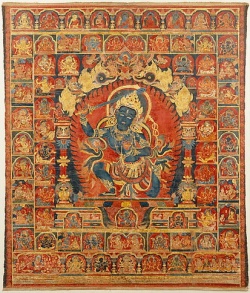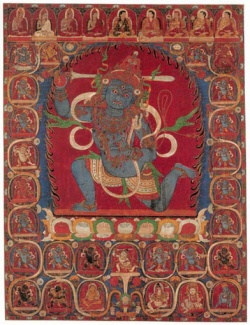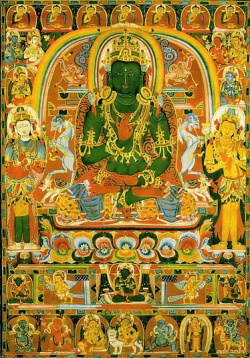Ösel (yoga)
Ösel (tib. hod-gsal; 'od gsal), the Yoga of the Clear Light (often translated as 'Radiant Light' (Sanskrit: prabhasvara), referring to the 'intrinsic purity' (Tibetan: ka-dag) of the substratum of the 'mindstream' (Tibetan: sems-rgyud) is a sadhana found in Vajrayana and Bön centered on the state of luminous clarity. Many versions, derivatives and accretions of the sadhana are extant. Ösel is generally included amongst the Six Yogas of Naropa and its sister tradition the Six Yogas of Niguma. Ösel is also an experience of 'rigpa' the 'reflexive apperception' (Sanskrit: Svasaṃvedana, Wylie: rang rig pa) of the mindstream.
Nomenclature, orthography and etymology
In a key scholarly collaborative Nyingmapa translation work published in 2005, furthermore notable as the first complete rendering of the Bardo Thodol into the English language from the Tibetan, this technical term was configured into English as "Inner Radiance".
Fremantle (2001: p.199) states:
- Luminosity is often translated as "clear light," which is a literal rendering of the Tibetan rather than the Sanskrit. Trungpa Rinpoche did not like that term, although he did sometimes use it in his talks, which form the basis of his books, because it is so well known. He felt it had become inextricably associated with such notions as the light at the end of the tunnel in near-death experiences, and that it gave too much of an impression of ordinary, visual light, whereas what is meant is an extremely subtle concept that he thought would be conveyed better by "luminosity."
The original Sanskrit term, prabhāsvara, has been translated as "translucent" and "luminous clarity."
Definitions
Patrul Rinpoche et al. (1994: p.410; p.403) define 'Clear light' (Tibetan: 'od gsal) as the:
- ...spontaneous, luminous (or knowing) aspect of the nature of Mind - or awareness (rig pa), the original state of Mind, fresh, vast, luminous, and beyond thought.
In the tradition of Namkha'i, it is held that Ösel reveals the natural luminosity of emptiness, the 'true nature of Mind' (Sanskrit: cittatva). Ösel is taught as one part of the six yogas of Naropa.
Keown, et al. (2003) identify the Ösel or "clear light", as that by which the natural luminosity (Five Pure Lights) of emptiness (Śūnyatā) is apprehended.
Berzinn the Berzin Archives Glossary, identifies the "mental continuum" (Sanskrit: citta santana) as constituted by the "clear light awareness" which is his rendering of ‘od-gsal (Wylie). Berzin defines ‘od-gsal thus:
- The subtlest level of mental activity (Mind), which continues with no beginning and no end, without any break, even during death and even into Buddhahood. It is individual and constitutes the mental continuum of each Being. It is naturally free of conceptual cognition, the appearance-making of true existence, and grasping for true existence, since it is more subtle than the grosser levels of mental activity with which these occur. IT is named the Light.
Commentary and critique
Kapstein (2004: p.124) in mentioning the Aṣṭasāhasrikā Prajñāpāramitā and Haribhadra states:
- Despite the effulgent imagery with which the discourses of the Mahāyāna are suffused, we must be very cautious about the interpretation of philosophical and mystical references to the Light and radiance even here. While it is clear that the authors of the Mahāyāna do wish to assert that the encounter of aspirants with Buddhas and other exalted beings may be marked by intensive visions of the Light, it is much less clear that they wish to impart any sense of metaphysical intimacy to these discourses of luminosity. An excellent, short example of this reticence may be found in connection with the interpretation of a very widely cited sentence near the beginning of the Aṣṭasāhasrikā Prajñāpāramitā (The Perfection of Wisdom in Eight Thousand Lines): "Mind is not mind. The nature of Mind is clear light" (tac cittam acittam. prakṛtiś cittasya prabhāsvarā). Though some later Tibetan authors do suggest that this lends support to the concept of a sort of luminous spiritual substance underlying the mind, the most influential of the Indian commentators on this text, Haribhadra, by contrast says: "Wherefore it is far removed from the nature of the one and the many, the nature, or essence, of Mind, being unoriginated, is clear Light" for the darkness of all conceptions of being is destroyed." Thus, Haribhadra will commit himself to no more than a metaphorical interpretation of the Light of Mind. In this, his perspective seems entirely continuous with the dominant scholastic trends of early Buddhism.
Practice
Mother and child luminosities
A fundamental distinction in the Dzogchen literature of 'od gsal (Wylie) is that of 'inner radiance of the ground' (Wylie: gzhi'i 'od-gsal) and the 'inner radiance of the path' (Wylie: lam-gyi 'od-gsal); otherwise known as the mother and child luminosity respectively.
Fremantle (2001: p.198-9) states:
- The luminosity experienced in meditation is called the path luminosity, simile luminosity, or child luminosity. The true luminosity of our awakened nature is called the basic luminosity or mother luminosity; it dawns at the moment of death, and if it is recognized, the mother and the child meet and become one in liberation.
Patrul Rinpoche et al. (1994: p.406) define 'Clear light of the moment of the ground' (Tibetan: gzhi dus kyi 'od gsal)' as the:
- ...nature of the mind of all beings, pure from the beginning and spontaneously luminous; fundamental continuum (of awareness), potential of Buddhahood...It can be "introduced" by a realized master to a disciple, who then stabilizes and develops that experience through the profound practices of the Great Perfection. Ordinary beings perceive it only for a flash at the moment of death.
For further discussion on the 'pointing out instruction' refer Esoteric transmission.
Luminous liminalities
Cuevas (2003: p.63) conveys how the luminosity is significantly associated with states, portals or continuums of 'liminality' (Sanskrit: antarabhāva) such as 'completion phase meditation':
- "...the far-ranging tantric concept of luminosity or clear light ('od-gsal) said to be experienced briefly by all human beings at the moment of death, by advanced yogic practitioners in the highest levels of the completion phase meditation, and unceasingly by all buddhas. Interestingly, this very subtle radiance is believed also to be experienced, though rarely noticed, in more mundane moments such as fainting, sneezing, and orgasm, as well as in the first instant before and after dreaming."
Dream[less]work
The sadhana of Ösel may subsume elements of lucid, conscious sleep without dreams and therefore may be engaged as a complement of Milam and Gyulu. Practitioner will not lose consciousness on the onset of sleep/death, but awakens instantly into the Clear Light. This state is reachable and sustainable only for advanced meditators.



